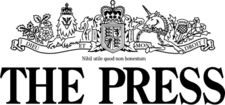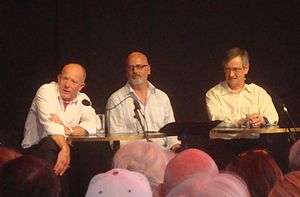The Press
 | |
|
| |
| Type | Daily newspaper |
|---|---|
| Format | Broadsheet |
| Owner(s) | Fairfax Media |
| Editor | Joanna Norris |
| Founded | 25 May 1861 |
| Headquarters |
|
| Circulation | roughly 80,500 |
| Website | www.press.co.nz |
The Press is a daily broadsheet newspaper published in Christchurch, New Zealand. It is owned by Fairfax Media.[1]
History

James FitzGerald came to Lyttelton on the Charlotte Jane in December 1850, and was from January 1851 the first editor of the Lyttelton Times, Canterbury's first newspaper.[2] From 1853, he focussed on politics and withdrew from the Lyttelton Times.[3] After several years in England, he returned to Canterbury concerned about the proposed capital works programme of the provincial government, with his chief concern the proposed rail tunnel connecting Christchurch and Lyttelton, which he thought of as fiscally irresponsible, but supported by his old newspaper, the Lyttelton Times. The newspaper's editor, Crosbie Ward, made an imputation of unknown content, and this spurred FitzGerald to set up The Press as a rival newspaper.[4]
FitzGerald had dinner with John Charles Watts-Russell, who put up £500 on the condition that FitzGerald would be in charge of the new newspaper. Next, he enlisted the support of the Rev. John Raven, who organised many of the practical aspects, like organising a printer and a printing press. Other members of the early committee that organised The Press were H. P. Lance, Henry Tancred, and Richard J. S. Harman; all of them were colonial gentry.[5]
The Press was first published on 25 May 1861 from a small cottage, making it the oldest surviving newspaper in the South Island of New Zealand. The cottage belonged to Raven on land known as Raven's paddock on the west side of Montreal Street, between Worcester and Gloucester Streets, opposite the present-day Christchurch Art Gallery.[6] The first edition was a six-page tabloid and was sold for sixpence. The paper continued as a weekly. The public saw FitzGerald as the proprietor of The Press, but the newspaper saw reason to publicly state that "it is not a fact that Mr FitzGerald has either pecuniary or official connexion" with it; he was however the driving force behind the paper.[6]
In February 1862, an attempt was made to form a company and formalise the ownership of the paper. A deed of association for "The Proprietors of The Press" was drafted, and it lists the five members of the previous committee (Watts-Russell, Raven, Lance, Tancred, and Harman), plus five new members: Alfred Richard Creyke, John Hall, Joseph Brittan, Isaac Thomas Cookson, and James Somerville Turnbull.[7] Surprisingly, the deed was not executed, but four month later, FitzGerald, who had no funds, was the sole owner "through the liberality of the proprietors", as he called it later.[8]
On 13 June 1863, the first part of Samuel Butler's Erewhon appeared in The Press in an article signed with the pseudonym Cellarius (q.v.) and headed "Darwin among the Machines."[9]
In 1905, The Press purchased a block of the Cathedral Square site for £4,000. The Board then purchased the right of way (Press Lane) and what was going to be the original Theatre Royal site from the Theatre Royal Syndicate for £5000. The Gothic part of the Press building (occupied by the company until 22 February 2011) was built starting in 1907 and the Press staff shifted into it in February 1909 from their Cashel Street premises.
In the 1930s, The Press began to seek solutions to the slow delivery times of the newspaper to the West Coast. Roads at the time were difficult, and the New Zealand Railways Department was unwilling to re-schedule any of its ordinary passenger trains to operate at the early morning times desired by The Press as patronage would have been uneconomic, and freight trains did not provide a desirable measure of swiftness. Accordingly, The Press was willing to subsidise the construction and operation of two small Leyland diesel railbuses to carry the newspapers by rail at a desirable time. These little railbuses began service on 3 August 1936 and left Christchurch at 2:20am, travelling down the Midland Line to reach Greymouth at 6:40am and then continue along the Ross Branch as far as Hokitika, arriving just before 8:00 am. This provided substantially quicker delivery of the newspaper than was previously possible. However, these railbuses were intended to only be a temporary measure and they were replaced by the much larger Vulcan railcars as soon as they arrived in New Zealand in the early 1940s.
In February 2011, The Press main building in central Christchurch was badly damaged in the 2011 Christchurch earthquake. All production was operated from their printing plant near Christchurch Airport until June 2012, when the central Christchurch building was partially rebuilt and upgraded. It was one of the first buildings in the Christchurch CBD to be rebuilt and operational.
Today

The newspaper is the largest circulating daily in the South Island and publishes Monday to Saturday. The community newspapers—Mid Canterbury Herald, The Christchurch Mail, Northern Outlook and Central Canterbury News—are also published by The Press and are free.
Today, the newspaper is a well-respected member of the four main daily newspapers, circulating over 80,000 papers per day through the South Island.
The Press won the Best New Zealand Newspaper award and also picked up Best Daily Newspaper with a circulation over 25,000 at the 2006 Qantas Media Awards and won the same award again in 2007. It is the first time since 1991 that any New Zealand newspaper has achieved this feat. It also won several other awards including best-in-field awards for its "Zest" and "Drive" sections.
In 2011, The Press won Best Design at the Canon Media Awards,[10] and Best Breaking News Coverage for thepress.co.nz for the coverage on the 22 February Earthquake in Christchurch. The Press also claimed Newspaper of the Year at the PANPA awards [11] for the 25,000 - 90,000 circulation category.
Motto
The motto on the masthead — "Nihil utile quod non honestum" translates to "Nothing is useful that is not honest." Like The Age in Australia, the newspaper's masthead features the Royal Arms.
Editors
The following have been editors of The Press:[12]
- 1861: George Sale
- 1861–1868: Joseph Colborne-Veel
- 1868: Charles Purnell[13]
- 1868–1878: Joseph Colborne-Veel (second period)
- 1878–1894: John Steele Guthrie
- 1894–1919: Michael Cormac Keane
- 1919–1929: William Henry Triggs
- 1929–1932: Oliver Duff
- 1932–1957: Pierce Hugo Napier Freeth
- 1957–1973: Arthur Rolleston Cant
- 1973–1978: Norman Macbeth
- 1978–1990: Binney Lock[14]
- 1990–1997: David Wilson
- 1997: Bruce Baskett
- 1997–2001: Tim Pankhurst[15]
- 2001–2007: Paul Thompson[16]
- 2007–2012: Andrew Holden[17]
- 2012–present: Joanna Norris
See also
Notes
- ↑ "Profile of The Christchurch Press". Fairfax Media. Archived from the original on 2007-09-18. Retrieved 2007-10-13.
- ↑ "About the Lyttelton Times - January 11, 1851". Christchurch City Libraries. Retrieved 1 April 2011.
- ↑ McIntyre, W. David. "FitzGerald, James Edward - Biography". Dictionary of New Zealand Biography. Ministry for Culture and Heritage. Retrieved 6 November 2012.
- ↑ Christchurch Press Company 1963, p. 11.
- ↑ Christchurch Press Company 1963, pp. 11–13.
- 1 2 Christchurch Press Company 1963, p. 16.
- ↑ Christchurch Press Company 1963, p. 29.
- ↑ Christchurch Press Company 1963, p. 32.
- ↑ Preface to the Revised Edition, Project Gutenberg eBook Erewhon by Samuel Butler. Release Date: 20 March 2005.
- ↑ http://www.canonmediaawards.co.nz/
- ↑ http://panpa.org.au/awards/
- ↑ Christchurch Press Company 1963, p. 270.
- ↑ Scholefield 1940, p. 190.
- ↑ Law, Tina (17 November 2014). "Former Press editor was 'the ultimate gentleman'". The Press. p. A3.
- ↑ "New editors appointed to The Press and Nelson Mail". National Library of New Zealand. Retrieved 16 November 2014.
- ↑ "New Editor for The Press" (Press release). Fairfax Media. Scoop. 9 November 2007. Retrieved 16 November 2014.
- ↑ "Christchurch Press editor to head Melbourne Age". The Press. 26 June 2012. Retrieved 16 November 2014.
References
- Christchurch Press Company (1963). The Press, 1861–1961; the Story of a Newspaper. Christchurch: Christchurch Press Company.
- Scholefield, Guy, ed. (1940). A Dictionary of New Zealand Biography : M–Addenda (PDF). II. Wellington: Department of Internal Affairs. Retrieved 18 January 2014.
